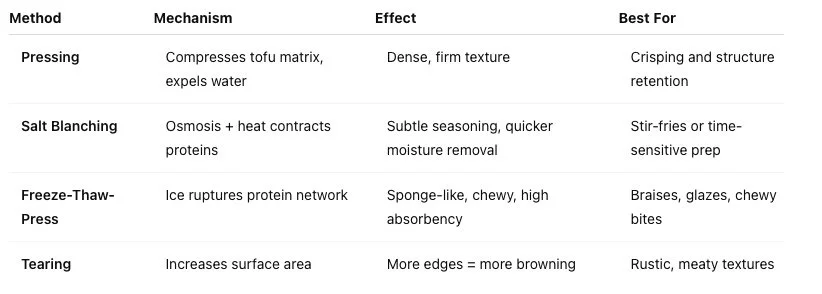Crispy Tofu Without Oil: Air Fry, Bake, or Roast It?
Why This Matters Tofu crispness isn’t just about crunch—it’s a culinary pursuit of texture, flavour, and structural integrity. For chefs and home cooks alike, mastering crisping techniques without resorting to deep frying reveals tofu’s full potential. Whether it's through air frying, baking, or convection roasting, each method offers unique control over moisture, texture, and browning. And for health-forward kitchens, these low-oil methods are indispensable.
Sustainability Note: Air fryers and convection ovens are often more energy-efficient than deep fryers, using less electricity and producing less ambient heat—making them better for both your kitchen and the planet.
🧪 The Science Behind the Crisp
Crispness = Dehydration + Maillard Reaction + Structure Formation.
Dehydration: Water evaporates from the tofu’s surface. Browning can occur only once the temperature rises above 100°C (212°F).
Maillard Reaction: Starts at ~140°C (284°F), where amino acids and reducing sugars react to form golden crusts and complex savoury notes.
Starch Gelatinisation & Retrogradation: Starch absorbs water, swells, then dries into a brittle shell. Cornstarch is ideal due to its high amylose content (25–28%).
Protein Denaturation: Tofu's 7S and 11S globulins unfold and coagulate at ~70–90°C, tightening the matrix and improving chew. This process also enhances digestibility by breaking down complex protein structures.
These aren’t isolated steps—they cascade. Dehydration allows the Maillard reaction. That enables starch retrogradation and protein locking. It’s edible engineering.
🔧 Preparation Is Everything
Tofu texture starts before the heat hits.
Note: Super-firm vacuum-packed tofu often needs only blotting, not pressing.
1. Air Frying: The Precision Crisp
Best for: Cubes, nuggets, snacks; ultra-crisp surfaces
Mechanism: High-speed convection in a compact chamber creates rapid surface dehydration and efficient browning via concentrated airflow.
Expert Tips:
Use a light starch dusting—not a slurry—for a fine, brittle crust.
Shake midway for even airflow.
Preheat for faster Maillard onset.
Don’t crowd: excess steam = sogginess.
Cooling Tip: Transfer to a wire rack post-cook to preserve crispness.
Optional Oil Tip: While oil-free is entirely possible, a light spray of high-smoke-point oil can enhance browning and add depth for those seeking a more “fried-like” crust.
Drawbacks: Smaller batches, potential interior dryness unless using dense or freeze-thawed tofu.
2. Oven Baking: The Batch-Friendly Infuser
Best for: Marinated tofu, bulk prep, mild crisping
Mechanism: Radiant heat slowly drives off moisture, allowing marinades to penetrate while creating a gentler crisp.
Expert Tips:
Bake at 200°C (400°F) for 25–35 minutes.
Flip halfway; broil last 3–5 minutes for added texture.
Use parchment or silicone mats for evenness.
Avoid crowding to prevent steam buildup.
Oven Calibration Note: Use an oven thermometer—many ovens run hotter or cooler than their settings.
Drawbacks: Slower cook times; less intense crust unless broiled.
3. Convection Roasting: The Texture Architect
Best for: Glazed slices, torn tofu, pre-frozen slabs
Mechanism: Combines radiant heat and circulating air to promote deep dehydration and chewy-crisp contrast.
Fan Intensity Note: Not all convection ovens are created equal. Built-in ovens typically have larger cavities and gentler airflow compared to countertop air fryers. This can mean slower moisture removal and softer crisping unless compensated with higher temperatures or longer times. Expect variability based on fan strength, chamber volume, and positioning.
Expert Tips:
Roast at 220°C (425°F). Brush glaze in the final 10 minutes.
Use a wire rack to allow underside airflow.
Pre-freeze and press tofu for interior chewiness.
Drawbacks: Risk of over-drying thin pieces; not as aggressive as air fryers for crisping.
🧠 Troubleshooting Common Issues
Tofu not crisping? Likely too much moisture. Try pressing, tearing, or using a drier tofu type.
Too dry or rubbery? Overcooked or pieces are too thin. Use thicker slabs or reduce time.
Still soggy? You’re probably overcrowding the tray—use spacing.
Lacks browning? Surface temp is too low. Broil or raise the temp. A light starch coat helps.
Texture faded after resting? Cool on a wire rack, not flat plates.
Microwaving leftovers? Reheat in the oven or air fryer instead.
🍽️ Advanced Applications & Serving Ideas
Tofu Croutons (Air Fry): Dust cubes in cornstarch + paprika. Crisp, then toss into Caesar or tabbouleh.
Tofu Nuggets (Torn, Air Fry): Starch coat, crisp. Serve with gochujang mayo or BBQ glaze.
Bánh Mì Fillers (Oven): Marinate in tamari-maple. Bake and broil. Stack with pickled veg.
Glazed Convection Cuts: Roast slabs, then brush with sesame-chilli glaze for miso veg bowls.
Hearty Wraps (Convection): Pair chewy tofu slices with roasted pumpkin, tahini and greens.
🌏 Beyond Crisp: Mastering the Texture Spectrum
Tofu is a shape-shifter. From velvety to chewy to layered, here’s how to think beyond crisp.
Yuba Note: Made from soy milk skin, it brings a nutty chew and is ideal for pan-searing or braising.
Pro Tip: 🧈 Blend silken tofu with garlic, lemon, or miso for sauces, dips, or spreads that are silky and protein-rich.
⚖️ Which Method When?
Final Note
Crisping tofu is a culinary art of moisture, structure, and flavour. Whether you’re crafting ultra-thin crusts or chewy-centred bites, understanding the science gives you control. Each method, each preparation, is a tool in the tofu texture toolbox. Let’s reimagine tofu—crispy, chewy, flavour-packed, and deeply satisfying—without the deep fryer.




